BHUTAN - 2008
 Friday, April 10, 2015 at 08:29PM
Friday, April 10, 2015 at 08:29PM We had seen what the passage of time had done to the pretty little Swiss village of Grindelwald in the half century since Suzy first went there as a child: paved roads to places high above the village that used to be almost inaccessible; a car park where the ice rink had been, etc., etc. Bhutan had been touted as a largely undiscovered Himalayan kingdom and we wanted to get there before it, too, was modernized beyond recognition.
Ellie and Suzy
Bhutan is not easy access. As the old joke goes, if you want to go to Bhutan, it's best not to start from Washington. But we had no choice. We were looking at flights of six hours to Los Angeles, twelve from there to Tokyo; another six from Tokyo to Bangkok, and then three more to Bhutan. With layovers in between. One of us argued that if we were going to go that far and that long we should consider adding a few days in Cambodia to visit Angkor Wat. This suggestion was met with, "Anchor what?" After a bit of cultural enlightenment, she agreed both to that and a few days in Bangkok for jet-lag recovery and some really good food.
We began the last leg of the trip into Bhutan in a disturbingly typical way by misreading the hour of our departure from the airport in Bangkok. We had roused ourselves at 2:00 am in order to get to the airport in time for a flight that we thought was scheduled to leave at 5:50. In fact it wasn't due to depart until 6:50 a.m, and we could have had a leisurely lie-in until 3:00 a.m. In time the other members of our group began to show up, along with our guide, and we were soon airborne on Drukair, or Royal Bhutan Airlines.
The airport at Paro is the only international airport in Bhutan, and the landing is one of the most difficult in the world. The runway is in a narrow valley and planes circle around and thread their way between 18,000 foot high mountains, their wings seeming to barely miss the trees at the lower elevations. At the time we went there were only eight pilots in the world certified to land at Paro. In poor weather they don't even attempt take offs or landings. If you're already there, you stay there; if you're hoping to get there, you won't.
Approach to ParoIn addition to being famously happy people, the Bhutanese are also patient people. We were given every opportunity to practice that virtue at the airport, but eventually were on our way. We stopped to gawk at an outdoor food market before continuing to the “resort” where we were to spend several days. The word “resort” conveys an altogether false impression of the place, but it was spotlessly clean, everyone working there was friendly, and the cool weather was very welcome after Cambodia.
Paro market
Lunch, was typical of what we came to expect every day: large warming dishes were set out in a row on a table and guests served themselves. One always contained red rice, one a meat of some sort, and the others vegetables and stews. Our guide would station himself strategically where he could warn us off taking any food containing the extremely hot chilies that are so popular in Bhutan, but are incompatible with most Western throats. One day when we were feeling particularly independent we ignored his warning, but we never did that again.
After lunch we were taken to the Paro Rinpung Dzong. Dzongs, with their very distinctive architecture, are found in Bhutan and Tibet. They usually serve several functions – military, religious, and administrative. They are enclaves of serenity; if there is any sound at all it is likely to be monks softly reciting a prayer of some sort. Some dzongs have areas which are forbidden to women; all require removal of shoes or boots on entry.
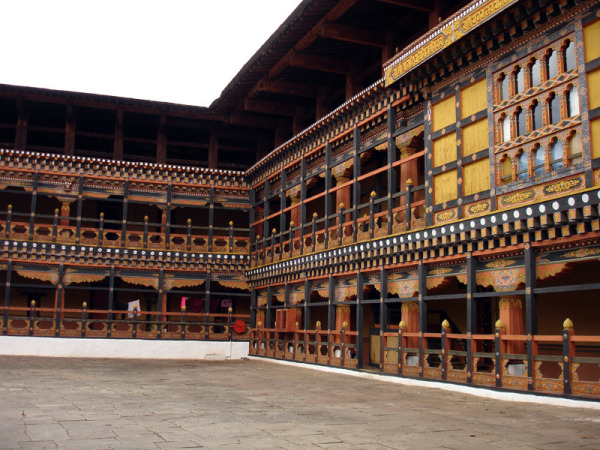 Paro Rinpung Dzong
Paro Rinpung Dzong
Another dzong we visited later that day was the Drukgyel Dzong, or “Victorious Dzong of the People of the Land of the Thunder Dragon.” (A linguistic note: “Druk” means “Thunder Dragon,” and Druk-yul” is “Land of the Thunder Dragon,” which is how the Bhutanese refer to their own country.)
Bhutan has tried to hold modernity at arm's length, and for many years its isolation, landlocked between India and China, coupled with strong Buddhist traditions, made that possible. Before 1961 the country had no paved road. The first and only traffic light in the country was installed in the capital of Thimpu, but it wasn't popular and was soon removed. Shortwave radio reached Bhutan in 1991, and the first television transmission occurred im 1999. Men and women are required to wear traditional dress in public during daylight hours. On the way back to our hotel we stopped to watch a woman winnowing rice in what was an almost biblical scene.
Winowing rice
A meteorological depression had settled over the distant Bay of Bengal, but it was close enough to send us a day and a night of non-stop rain. Our guide had to quickly come up with an alternative to hiking and produced a traditional dance troupe, men and women, who were accompanied by some stringed instruments and two gigantic (and relentlessly monotonal) temple horns.
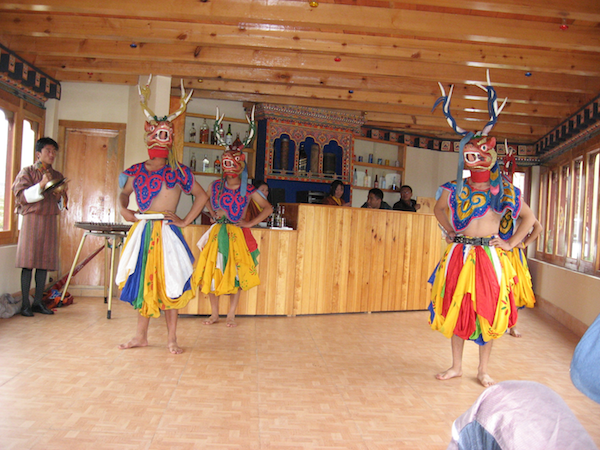 Dancers The pièce de résistance for walkers in Paro is Paro Taktsang, or Tiger's Nest, the Buddhist monastery perched on a precipitous cliff 3000 feet above the valley floor. It is probably the iconic photograph of Bhutan, and the legends surrounding its construction abound. Some of them feature a flying tigress – hence the name. It's a breathtaking climb, and at 10,240 feet above sea level there's not a lot of breath to spare. There are several viewing points along the way for those who choose not to go the whole way, but we persevered. Once there it required countless boots on, boots off operations, to be allowed to enter the various temples and caves. Our conclusion: for non-Buddhists, the exterior view is quite stupendous enough.
Dancers The pièce de résistance for walkers in Paro is Paro Taktsang, or Tiger's Nest, the Buddhist monastery perched on a precipitous cliff 3000 feet above the valley floor. It is probably the iconic photograph of Bhutan, and the legends surrounding its construction abound. Some of them feature a flying tigress – hence the name. It's a breathtaking climb, and at 10,240 feet above sea level there's not a lot of breath to spare. There are several viewing points along the way for those who choose not to go the whole way, but we persevered. Once there it required countless boots on, boots off operations, to be allowed to enter the various temples and caves. Our conclusion: for non-Buddhists, the exterior view is quite stupendous enough.
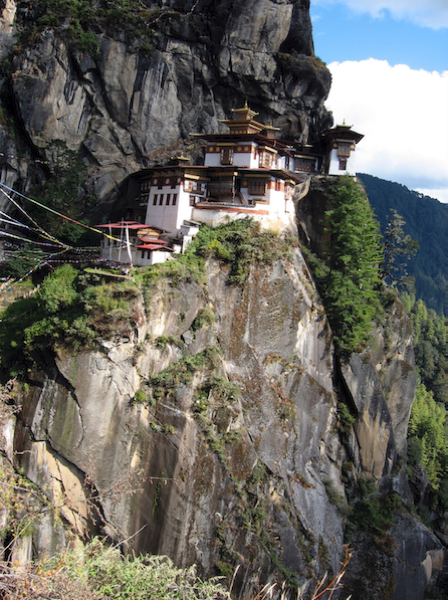 Tiger's NestNext we were to spend a few days in Punakha. Unfortunately for us, (in some ways) our visit coincided with the coronation ceremony of the new young king in a dzong there, and our hotel reservations had been summarily commandeered by more important coronation guests. This required some extra work for our guide; hotels suitable for tourists are thin on the ground in Bhutan. The best he could do was a grubby little hostelry in the small village of Wangdue. It offered the added attraction of sharing the bathroom with insects that would have been terrifying even had they been dead. After dinner that night our guide expounded on his deep affection and reverence for the royal family, and for religious authorities. Indeed, as we had walked along the road earlier that day we were passed by a large car that he thought must contain important people, and he asked us to stop and bow our heads respectfully as it went by.
Tiger's NestNext we were to spend a few days in Punakha. Unfortunately for us, (in some ways) our visit coincided with the coronation ceremony of the new young king in a dzong there, and our hotel reservations had been summarily commandeered by more important coronation guests. This required some extra work for our guide; hotels suitable for tourists are thin on the ground in Bhutan. The best he could do was a grubby little hostelry in the small village of Wangdue. It offered the added attraction of sharing the bathroom with insects that would have been terrifying even had they been dead. After dinner that night our guide expounded on his deep affection and reverence for the royal family, and for religious authorities. Indeed, as we had walked along the road earlier that day we were passed by a large car that he thought must contain important people, and he asked us to stop and bow our heads respectfully as it went by.
A long, twisting drive through the Punakha Valley took us to a trailhead that was the starting point for the climb up to Khamsung Yuely Namgyel Temple. It's another stunning sight in a spectacular location. There are so many of them in Bhutan that one runs out of adjectives.
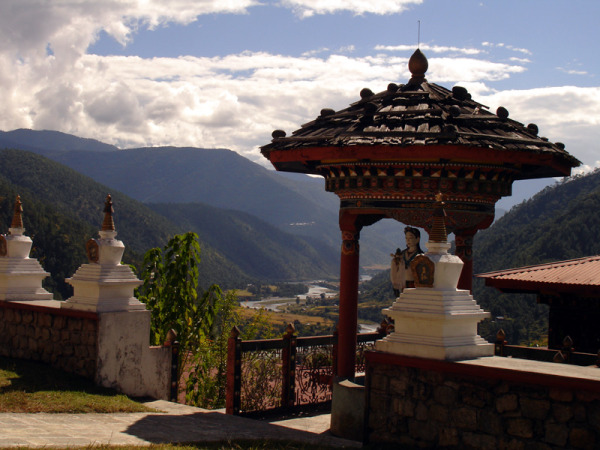 Kamsung Yuely Namgyel Temple
Kamsung Yuely Namgyel Temple
On the way back we had to cross a suspension bridge, said to be the second longest in the world. One of us doesn't like suspension bridges, but seeing the many colorful prayer flags that had been attached to the sides of the bridge, she set out across it with confident Buddhist serenity.
Suspension Bridge
There was time before dinner and we needed a reason – any reason – to get out of our sad little hotel. We usually kill time by playing cards, but that was ruled out by the presence in the hotel of a woman who seemed desperate to join us, if allowed, and failing that, watch us and prompt us in how to play. So we walked to a nearby temple complex where we watched dancers rehearsing for the upcoming coronation. The young monks - some as young as eight - were being given their evening meal of rice, scooped out of a large pot and into their own bags, which they would then take up to their dormitories. Lucky ones might have received somethng sent from their families to add to the rice. We chatted briefly with a little boy of five who told us that he had tried being a monk but decided against it and left the monastery.
Dancers in WangdueWangdue was some distance from Punakha, and to get to the trailhead the next morning we had to drive directly past the dzong in which the coronation was to be held a few hours later. Our original schedule had called for a visit to the dzong, but that was off limits because of the coronation. However, in exchange for missing that we were treated to the dazzling sight of thousands of Bhutanese walking along the roads, coming in from every direction and some from miles away, on their way to the dzong - dignitaries, monks, men, women, old and young - the men in the traditional gho, and the women in long skirts and the kira - the short cropped jacket they wear - in every color of the rainbow.
Coronation parade
Despite heavy security, we as tourists were ushered through the police line. However, our guide asked for one volunteer to get out and ride in the small support truck that always followed us, just in case its “tourist” status was questioned. Ellie quickly agreed to go, and after she left he remarked jokingly “Well, that’s the last we’ll see of her!” From the trailhead it was a beautiful walk through rice paddies and fields to the Chorten Nebu Temple.
Rice paddies
The temple was under restoration and was little more than a construction site inside, but we were allowed to visit. Some very young monks from the nearby monastery appeared to lead us around and help us negotiate three precarious flights of stairs in almost total darkness. They insisted on holding our hands, making it far more treacherous than it would have if we’d been allowed to hold onto something more structural, but they were so eager and helpful that refusing the proffered assistance was out of the question. Staircases in Bhutanese buildings are almost vertical; it's no wonder that babies spend the bulk of their young lives swaddled safely onto the back of a sibling.
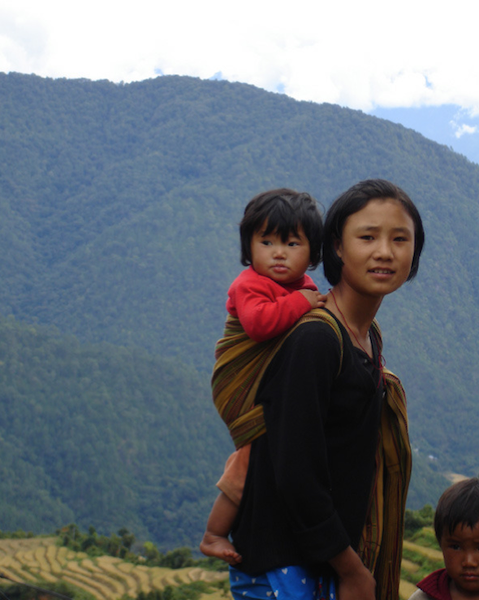 Bhutanese day care
Bhutanese day care
On our way back to Wangdue we again passed by the Punakha Dzong. The coronation was over, and the crowds were dispersing after a picnic the king had hosted for them on a large field next to the dzong.
We stopped by the river to have tea (tea seems to be a daily requirement, even when you’re tired and would much rather head straight home). Ellie needed to pee, and had just picked her spot by the river that was somewhat more concealed than anywhere else when two black cars roared up and out piled some of the royal children. And only then did we notice that the entire riverbank area was patrolled by security - seeing things they never expected to see.
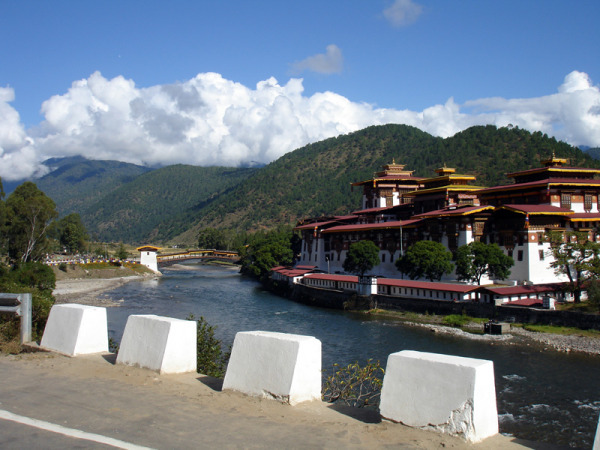 Punakha Dzong
Punakha Dzong
The next day we hiked up to the Dochula Pass on our way to Bhutan's capital, Thimphu. The Pass is 10,334 feet above sea leve[, and at its crest are 108 chortens or stupas (Buddhist shrines), fluttering prayer flags, and a 360˚panorama of the Himalayas. Everything about it takes one's breath away. From there we were driven down down to Thimphu.
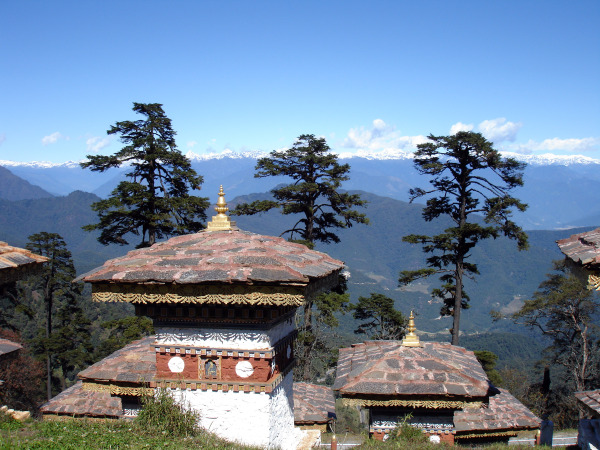 Chortens at Dochula PassThimphu is the closest thing to a metropolis that the country has to offer. It had at that time fewer than 80,000 residents, no airport, and, as previously mentioned, not a single traffic light. (They installed one, briefly, but it was soon taken down; the patient Bhutanese saw no need for it as they are always perfectly content to let the other car go first.) A few young people were wearing blue jeans, which we had not seen anywhere else. We dutifully fulfilled the tourist obligations in Thimphu: the Bhutan Textile Museum, the Institute of Traditional Medicine Museum, the Folk Heritage Museum, and the new National Library. We visited the Motithang Takin Preserve to see the goat-antelopes (also known as cattle chamois or gnu goats) found in the eastern Himalayas.
Chortens at Dochula PassThimphu is the closest thing to a metropolis that the country has to offer. It had at that time fewer than 80,000 residents, no airport, and, as previously mentioned, not a single traffic light. (They installed one, briefly, but it was soon taken down; the patient Bhutanese saw no need for it as they are always perfectly content to let the other car go first.) A few young people were wearing blue jeans, which we had not seen anywhere else. We dutifully fulfilled the tourist obligations in Thimphu: the Bhutan Textile Museum, the Institute of Traditional Medicine Museum, the Folk Heritage Museum, and the new National Library. We visited the Motithang Takin Preserve to see the goat-antelopes (also known as cattle chamois or gnu goats) found in the eastern Himalayas.
Weaver in Thimphu
Our last stop was the Handicrafts Emporium, where we each purchased a kira, fully aware that they would never look as attractive on us as they did on the Bhutanese women, and that we would probably never wear them when we got home. But we have worn them, just the once, and we got enough mileage out of that single exposure to justify the expenditure of $13 for one of them and $17 for the more elaborate one.
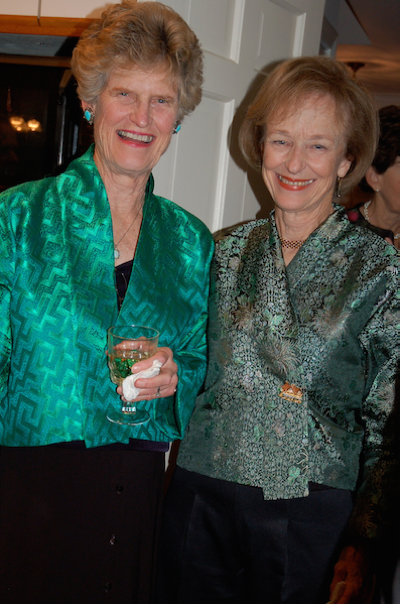 Cleaned Up Hikers in Traditional kirasThere was one final long hike up to a monastery and a walk back to Thimphu, where, on a large parade ground, we watched some of the rehearsals for the next coronation ceremony, due to take place three days later. The coronation celebrations were a movable feast with events taking place in different cities on different dates.
Cleaned Up Hikers in Traditional kirasThere was one final long hike up to a monastery and a walk back to Thimphu, where, on a large parade ground, we watched some of the rehearsals for the next coronation ceremony, due to take place three days later. The coronation celebrations were a movable feast with events taking place in different cities on different dates.
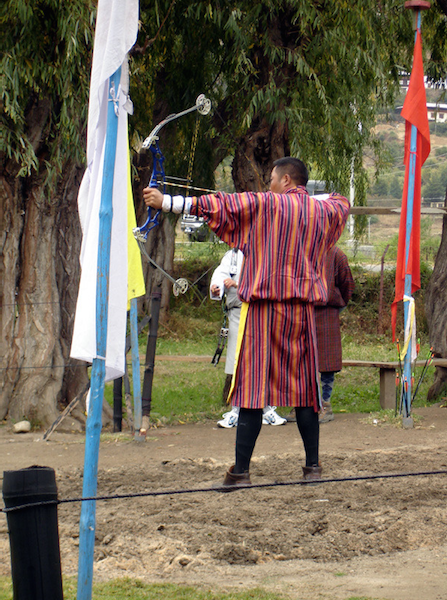 Bhutanese archer
Bhutanese archer
From Thimphu we had to return to Paro, since that was where the only international airport was. Flying out was just as terrifying as flying in, but once our heart rate had returned to normal and we had summoned up the courage to look out of the window we were pleased to be on the right side of the airplane for a glimpse of Mount Everest. It wasn't really a good glimpse because clouds and snow and countless other peaks conspired to make a definitive identification impossible, but we looked in the direction we were told to look, and we now claim to have seen it.
click here to see a gallery of the photos
